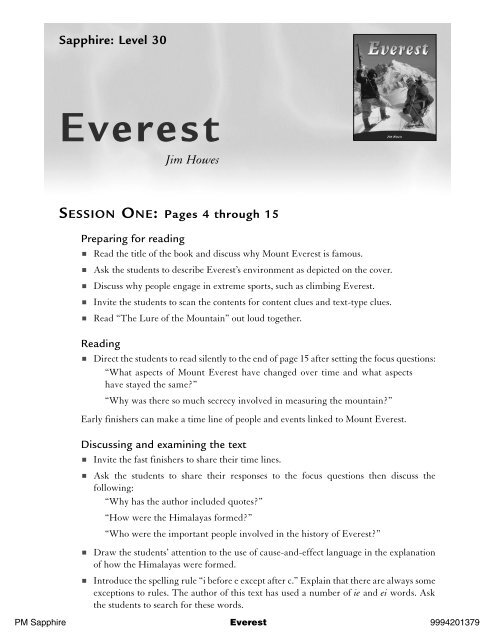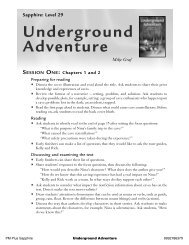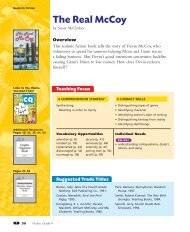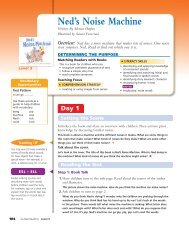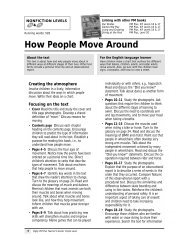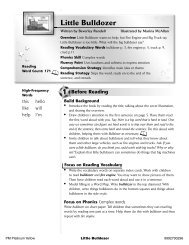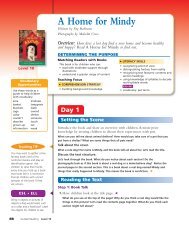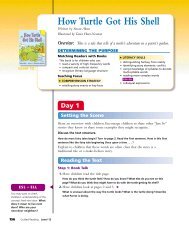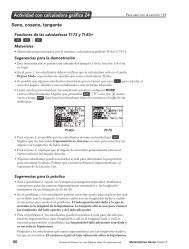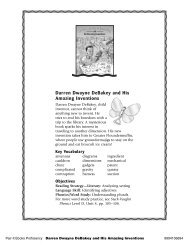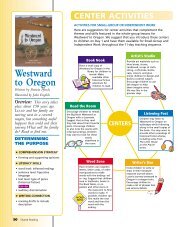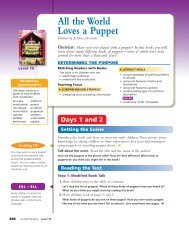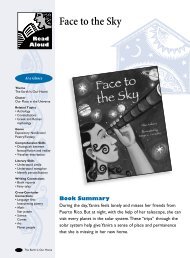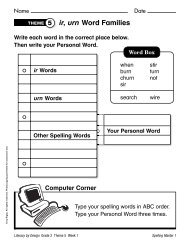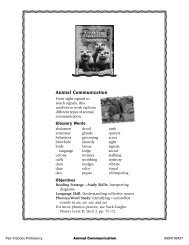Everest (PM Resources) Product Category: Leveled Reading ...
Everest (PM Resources) Product Category: Leveled Reading ...
Everest (PM Resources) Product Category: Leveled Reading ...
You also want an ePaper? Increase the reach of your titles
YUMPU automatically turns print PDFs into web optimized ePapers that Google loves.
Sapphire: Level 30<br />
<strong>Everest</strong><br />
Jim Howes<br />
SESSION ONE: Pages 4 through 15<br />
Preparing for reading<br />
■<br />
Read the title of the book and discuss why Mount <strong>Everest</strong> is famous.<br />
■<br />
■<br />
■<br />
■<br />
Ask the students to describe <strong>Everest</strong>’s environment as depicted on the cover.<br />
Discuss why people engage in extreme sports, such as climbing <strong>Everest</strong>.<br />
Invite the students to scan the contents for content clues and text-type clues.<br />
Read “The Lure of the Mountain” out loud together.<br />
<strong>Reading</strong><br />
■ Direct the students to read silently to the end of page 15 after setting the focus questions:<br />
“What aspects of Mount <strong>Everest</strong> have changed over time and what aspects<br />
have stayed the same?”<br />
“Why was there so much secrecy involved in measuring the mountain?”<br />
Early finishers can make a time line of people and events linked to Mount <strong>Everest</strong>.<br />
Discussing and examining the text<br />
■ Invite the fast finishers to share their time lines.<br />
■<br />
Ask the students to share their responses to the focus questions then discuss the<br />
following:<br />
“Why has the author included quotes?”<br />
“How were the Himalayas formed?”<br />
“Who were the important people involved in the history of <strong>Everest</strong>?”<br />
■<br />
■<br />
Draw the students’ attention to the use of cause-and-effect language in the explanation<br />
of how the Himalayas were formed.<br />
Introduce the spelling rule “i before e except after c.” Explain that there are always some<br />
exceptions to rules. The author of this text has used a number of ie and ei words. Ask<br />
the students to search for these words.<br />
<strong>PM</strong> Sapphire <strong>Everest</strong> 9994201379
Text Features and Teaching<br />
Opportunities<br />
Factual text — information report and explanation<br />
Use of visual text to enhance meaning — diagrams,<br />
photographs, illustrations, labels<br />
Vocabulary — technical terms<br />
Vocabulary — ie/ei words<br />
Cause and effect relationships<br />
Verbs and nouns<br />
Commas — to separate parts of a sentence<br />
Text structure — contents, headings, subheadings,<br />
glossary, and index<br />
Synopsis<br />
Mountains have fascinated people from many different<br />
cultures all over the world since time began. Mount<br />
<strong>Everest</strong> is the tallest mountain on Earth. So tall, in fact,<br />
that if a jumbo jet were flying past Mount <strong>Everest</strong> at its<br />
normal altitude, a climber at the top of the mountain<br />
would be able to wave to people through the windows of<br />
the plane! To the Nepalese and Tibetan people, Mount<br />
<strong>Everest</strong> is sacred, and both cultures refer to it as a goddess.<br />
Other cultures, on the other hand, are fascinated with<br />
climbing Mount <strong>Everest</strong>. But if one were to ask why, the<br />
answer would most likely be — because it’s there!<br />
SESSION TWO: Pages 16 through 25<br />
Before reading<br />
■<br />
Discuss the content of the previous chapters.<br />
■<br />
Ask the students to make a list of the sorts of items and clothing they think that they<br />
would need to take with them if they were to climb Mount <strong>Everest</strong>. Share the lists.<br />
<strong>Reading</strong><br />
■ Ask the students to silently read to the end of page 25 after setting the focus questions:<br />
“What are the main differences between 1920s climbing equipment and<br />
clothes and modern-day equipment and clothes?”<br />
“What are delusions?”<br />
“What is one of the mysteries of <strong>Everest</strong>?”<br />
Discussing and examining the text<br />
■ Ask the students to share their responses to the focus questions.<br />
“Why do climbers need to drink five to six quarts of water a day?”<br />
“Is it possible to rank the clothing and equipment in order of importance?”<br />
■<br />
■<br />
“Would Mallory and Irvine have gone missing in modern times?’’<br />
Explain how some words can be both verbs and nouns (eg., camp — to camp or set up<br />
camp). Ask the students to search for other examples of words that are nouns and verbs.<br />
Ask the students to find commas to separate parts of sentences.<br />
INDEPENDENT READING<br />
Have the students independently read the rest of the book after setting the focus questions:<br />
“What damage is currently being done to the Himalayan environment?”<br />
“Should there be restrictions for visits to <strong>Everest</strong>?”<br />
<strong>PM</strong> Sapphire <strong>Everest</strong> 9994201379
<strong>Everest</strong><br />
<strong>PM</strong> Sapphire<br />
F/P: T<br />
DRA: 50<br />
<strong>Everest</strong><br />
<strong>PM</strong> Sapphire<br />
F/P: T<br />
DRA: 50<br />
9994201379<br />
9994201379<br />
<strong>Everest</strong><br />
<strong>PM</strong> Sapphire<br />
F/P: T<br />
DRA: 50<br />
<strong>Everest</strong><br />
<strong>PM</strong> Sapphire<br />
F/P: T<br />
DRA: 50<br />
9994201379<br />
9994201379


